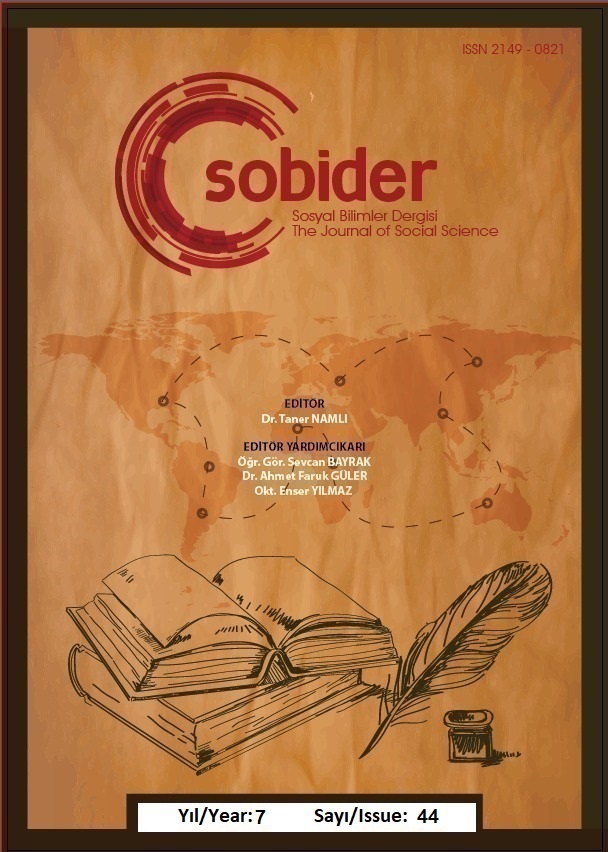Author :
Abstract
Su, yaşamın sürekliliğini sağlayan etkenlerden biridir. Suya duyulan gereksinim ve bu maddenin canlı yaşamına sağladıkları çağlar önce keşfedilmiş, uğruna savaşlar açılmıştır. Bilimden felsefeye, dinden sanata kadar insanlığı geliştiren her alanda su incelenmiştir. Anadolu halı ve kilimlerinde yaşama dair olgular, ihtiyaçlar ve beklentiler motifler aracılığı ile sembolize edilmektedir. Bu yüzden Anadolu insanı her gün muhtaç olduğu suyu ifade eden motifler geliştirmiş ve bu motiflere su ile özdeşleştirilen anlamlar yüklemiştir. Makalede; suyun fiziksel yapısı, inanç sistemlerindeki önemi, felsefi düşüncedeki yeri ve uygarlığın oluşumundaki rolü incelenmiştir. Saflık, soyluluk, bereket, arınma ve yeniden doğma gibi kavramlar ile bütünleşen suyun, Anadolu halı ve kilimlerinde aldığı biçim, sembolize ettiği anlam ve yüzey düzenlemelerindeki konumu anlatılmıştır. Suya yüklenen anlamların farklı sanat disiplinlerinde ele alınışı ve Anadolu halı ve kilimlerinde suyu tasvir eden motiflerin hangi formda ve dokumanın neresinde yer aldığı üzerinde durulmuştur.
Keywords
Abstract
Water is one of the factors that ensure the continuity of life. The need for water and what water provides for the living life have been discovered ages before, wars have been launched. Water has been examined in every field that develops humanity from science to philosophy, from religion to art. Matters and expectations of life are symbolized by motifs in Anatolian carpets and kilims. Therefore, Anatolian people have developed motifs expressing the water they need every day. In the article, the physical structure of water, its importance in belief systems, its place in philosophical thought and its role in the formation of civilization are examined. Water, which communes with the concepts such as purity, nobility, fertility, purification and rebirth, is explained in the form, symbolic meaning and surface arrangement in Anatolian carpets and kilims. It is emphasized that the meanings imposed on water are discussed in different disciplines and in which form the motifs depicting water are in Anatolian carpets and kilims and where they are in the weaving.
Keywords
- Alantar, Hüseyin, (2007), Motiflerin Dili, İstanbul Halı İhracatçıları Birliği, İstanbul.
- Altıer, Semiha, (2019), “Osmanlı Sanatında İbrik Tasvirleri ve İkonografisi”, Çanakkale Araştırmaları Türk Yıllığı, Sayı 26, s. 149-202.
- Aral, Necdet, (2000), Su, Medeniyet ve Teknoloji, Birleşik Yayıncılık, İstanbul.
- Arkas Koleksiyonu’nda Osmanlı Halı Sanatı, (2015), Arkas Holding A.Ş., İzmir.
- Atlıhan, Şerife, (2011), “Anadolu’da Kilim Geleneği”, 18.-19. Yüzyıl Anadolu Kilimleri Gülgönen Koleksiyonu, Vehbi Koç Vakfı, İstanbul, s. 32-75.
- Barutçugil, Hikmet, (2001), Suyun Rüyası Ebru Yaşayan Gelenek, Ebristan Yayınları, İstanbul.
- Diler, Ahmet, Gallice, Marc-Antonie, (2017), Kilimin Sembolleri, ALFA Basım Yayım Dağıtım San. Ve Tic. Ltd. Şti., İstanbul.
- Erbek, Mine, (2002), Çatalhöyük’ten Günümüze Anadolu Motifleri, T.C. Kültür Bakanlığı, Ankara.
- Etikan, Sema, (2007), ‘’Seccade Halılarda kullanılan Bazı motifler ve Bu Motiflerin İslam Sanatında Yeri’ ICANAS 38, Uluslararası Asya ve Kuzey Afrika Çalışmaları kongresi, Atatürk Kültür, Dil ve Tarih Yüksek Kurumu, s. 545-564.
- Fabbri Bilim ve Teknik Ansiklopedisi, (1984), Cilt: 10, Serhat Yayınları, İstanbul.
- Güllü, Saliha, Çatır, Ozan, (2017), “Uşak Halı Dokuma Sanatının Gelişimi, Özellikleri ve Turizme Etkilerine Yönelik Nitel Bir Araştırma”, Social Sciences Studies Journal, Cilt 3, Sayı: 10, s. 1285-1302.
- Hançerlioğlu, Orhan, (2015), Felsefe Sözlüğü, Cilt: 6, Remzi Kitabevi, İstanbul.
- Kemp, Martin, (2000), The Oxford History of Western Art, Oxford University Press, New York.
- Kılıçlıoğlu, Safa, (1971), “İbrik”, Meydan Larousse, Cilt 6, İstanbul.
- Kostrzewa, Tessa, (2001), “Resimde Mitologya ve Su Tanrıçalar, Periler, Denizkızları”, P Kültür Sanat ve Antika, Sayı 22, İstanbul, s. 65-81.
- Öztok, Deniz, (2006), Su, Suyun Yeryüzündeki Serüveni, Mikado Matbaacılık Ltd. Şti., İstanbul.
- Parlak, Tahsin, Ergüder, A., Aslıhan, (2010), Bardız Kilimleri, Zafer Ofset Ltd. Şti., Erzurum.





